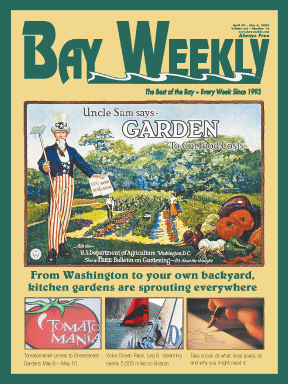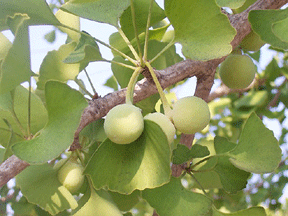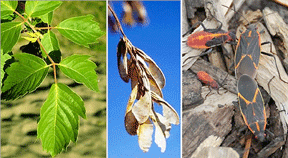
Volume XVII, Issue 18 # April 30 - May 6, 2009 |
 |
by Dr. Frank Gouin
Trees to Avoid
Female ginkos and box elder maple give you more than you bargain for
When you think of planting a new tree, here are two to avoid — at least in their female forms: ginko and box elder maple. Like hollies, ginko and box elder maple are dioecious, meaning the sexes are separate. The female plants produce fruit and/or seeds, and the male plants produce pollen.

![]() The leaves of the ginko tree, which was imported from China, are fan-shaped and two to three inches wide. When the trees are young, they are very asymmetrical with sparse branching, but they become symmetrical and more densely branched with age. The foliage has a rich green color that turns golden yellow in the fall. What’s so bad about that?
The leaves of the ginko tree, which was imported from China, are fan-shaped and two to three inches wide. When the trees are young, they are very asymmetrical with sparse branching, but they become symmetrical and more densely branched with age. The foliage has a rich green color that turns golden yellow in the fall. What’s so bad about that?
The female ginko produces a cherry-like fruit that, when ripe, generates an odor similar to fermented vomit, which is enough to gag a maggot. When the fruit falls to the ground, it is guaranteed to stick to the soles of your shoes and create a slippery mess that makes walkways dangerous. The fruit is a delicacy for Chinese people, and is sold as lechee nuts.
Now to the other nuisance, the box elder maple. The box elder maple is a native species prevalent in the forests of Southern Maryland. Like red, silver or sugar maple, box elder leaves are opposite on the branches. But it’s easily distinguished from other maples because its leaves resemble those of poison ivy. Each leaf is made from three greenish yellow leaflets attached to a petiole.
T hat’s not the worst of it. Female box elder maples attract the box elder bug, a charcoal gray insect with three bright orange-red stripes on its back. Box elder bugs feed on the female flowers and seedpods. During the late fall and winter months, box elder bugs like to invade your home and gather in large numbers on outdoor walls with a southern exposure.
hat’s not the worst of it. Female box elder maples attract the box elder bug, a charcoal gray insect with three bright orange-red stripes on its back. Box elder bugs feed on the female flowers and seedpods. During the late fall and winter months, box elder bugs like to invade your home and gather in large numbers on outdoor walls with a southern exposure.
The only solution is to find and kill the female trees and then treat the stumps to prevent them from sprouting suckers. The trees are most easily spotted in late August and September when they exhibit large clusters of seeds at the ends of the branches.
No and No Again to Hardwood Mulch
I read your article in Bay Weekly about over-mulching trees [April 16], shrubs and plants. You mention hard wood mulches, but what about pine bark mulch on acid loving shrubs?
–Bill Donnelly, via email
But Dr. Gouin: What then to use to keep moisture in and weeds out? Pine bark mulch blows and washes away and we’re trying to minimize chemicals.
–Barbara A. Kestenbaum, via email
Purchase the pine bark nuggets or the coarse grade of pine bark mulch. Shredded pine bark mulch is the best.
As far as weed control, I have never purchased a bag of mulch in my life. I use compost and Preen, which is nothing more than fluoride. It is the same chemical you get in drinking water except that it is arranged in a triangular form in Preen, and it breaks down from sunlight in about six weeks. It is approved for use in food crops. I even use Preen in my vegetable garden.